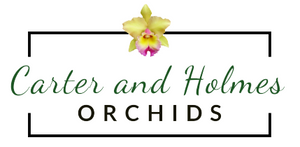Oeceoclades decaryana Care Sheet
Though little is known about the species Oeceoclades decaryana, we have had fairly good luck cultivating this small growing terrestrial orchid. Native to certain countries in Africa, they are found in areas of rocky terrain where organic debris and leaf litter collect in crevices.
Plants have small, hard pseudobulbs and short slender foliage. Generally, leaves drop after being on the plant only a season or two, but the bulbs remain to help sustain the plant through dry conditions. Our variety has darker olive green foliage with tan markings, but we other plants of this species have been known to have dark forest green leaves with lighter green markings. This may depend somewhat on growing conditions and fertilizer/media combinations. Roots seem to be strictly terrestrial in nature and rarely can be seen above the level of media, even when new roots or growths appear. We have also noticed that this species doesn’t freely make roots, so we are careful not to break or cut these when transplanting. Blooms are very tiny, about 1 cm across and will be in shades of olive green, cream and brown. We have seen as many as twenty tiny blooms on a single stem. Blooms stems are approximately 5”-6” tall and very tender.
The following culture has worked well for us in our greenhouses.
There are a couple of media options we recommend. First is a very light soil blend with a top dressing of fine grade Douglas Fir Bark. Second, you can also use fine grade Douglas Fir Bark with a small amount of turface and perlite added. Pot them in small tight containers with just enough room to accommodate the roots without breaking them. Fill with mix until the roots are covered and then a thin layer of bark. Repot only when the media breaks down, or not more than every two years.
We water them usually every 4-5 days, as soon as the media is somewhat dry around the roots though not dried out completely. Fertilize lightly about every 3rd or 4th watering with a balanced water soluble fertilizer. We have avoided getting fertilizer on the foliage, not knowing if they would be sensitive.
Cultivate in shady conditions, usually around 800-1000 foot candles with good air movement. Inadequate air movement can cause leaf drop or yellow/brown spotting.
Warm temperatures are preferred. We have aimed for winter lows around 65 degrees and summer highs around 85 degrees.

